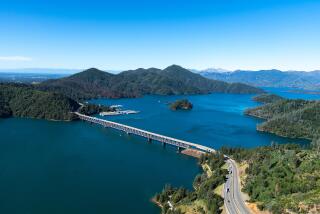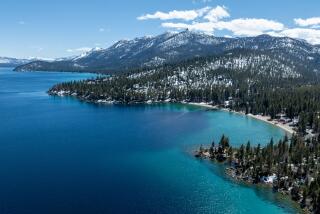Below-normal water deliveries to Southern California still forecast
It may be raining and snowing, but water managers are still forecasting below-normal deliveries this year for the state system that helps supply Southern California.
Storms have been filling Northern California’s big federal reservoir, Shasta Lake, but have been steering clear of the region that drains into Lake Oroville, the main reservoir in the state system.
“Every rainstorm seems to sit over Shasta and bypass our reservoir,” said Jerry Johns, deputy director of the state Department of Water Resources.
“We’ve picked up some storage in February, which has been great. But runoff is everything, and we’re not getting a whole lot of inflow.”
On Friday, the department released the latest in a series of delivery projections it makes during the rainy season.
It bumped up earlier estimates and said if weather patterns hold, it will increase allocations again for the State Water Project, which has typically provided the Southland with about a third of its water supply.
But Johns said that short of a deluge this spring, he didn’t see how state deliveries could reach normal levels.
The news was better for the Central Valley Project, which draws from Shasta and supplies much of California’s farm belt.
Federal officials said Friday that they hoped to give many agricultural contractors their full water allotments this year.
Shortages will continue on the west side of the San Joaquin Valley, where irrigation districts have junior rights and are the first to face cuts. But it appears farms there will still get enough water to head off a controversial proposal by U.S. Sen. Dianne Feinstein (D-Calif.).
This month, she drafted a jobs bill amendment that would have weakened Endangered Species Act protections that are curbing water deliveries to the valley from Northern California’s Sacramento-San Joaquin delta.
Feinstein’s move won praise from the farm community, but it was sharply criticized by many fellow Democrats in California’s congressional delegation. It set off a flurry of negotiations and meetings as Interior Department officials scrambled to supplement the west side’s deliveries and placate Feinstein.
Department officials said Friday that they had devised a series of water swaps and changes in delivery schedules that could boost the west side’s supplies 10% above what they would otherwise be, giving the area about 40% of its full allocation this year.
“We have stretched to do what we can for additional water supplies,” said Deputy Interior Secretary David Hayes. “It’s not magic. But we think it’s achievable.”
That satisfied Feinstein, at least for now. “This is very good news,” she said in a statement. “I will watch this situation carefully, and I am placing my proposed amendment on hold; however, I reserve the right to bring it back should it become necessary.”
Rep. George Miller (D-Martinez), one of the proposal’s critics, said Feinstein’s amendment “was universally recognized as a very bad idea. It leapfrogs over everybody else’s legal rights, water rights and environmental concerns . . . You just can’t do that.”
The center of the west side’s water shortages has been the Westlands Water District, a huge, politically influential irrigation district known for its aggressive tactics and fondness for lawsuits challenging environmental curbs on water deliveries.
Tom Birmingham, Westlands’ general manager, said a 40% allocation means “the people who live and work on the west side of the San Joaquin Valley will be able to survive while we pursue long-term solutions.”
The season’s El Niño-driven storms have filled Shasta to normal levels for this time of year. But Lake Oroville is only about half as full as it should be. If average precipitation continues, water resources officials said, they expect the state project will deliver 35% to 45% of the amounts contractors want.
That means the Metropolitan Water District of Southern California, which imports water from the state project, will again be delivering less to its urban customers. “It’s looking a lot like last year, frankly,” said Jeffrey Kightlinger, Metropolitan’s general manager. “We’re not out of the woods yet.”
More to Read
Sign up for Essential California
The most important California stories and recommendations in your inbox every morning.
You may occasionally receive promotional content from the Los Angeles Times.











